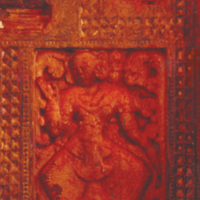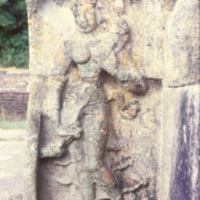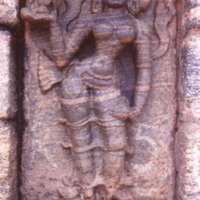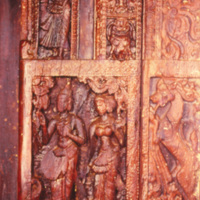Main Menu
AORC Libraries
Browse Archive Items (14 total)
Female dancers as guardians of temples
Description: Female door guardians or dvarapalikas in dance poses emphasize the devotional stance of these goddesses. This carved relief is at the bottom of one of the wooden door jambs at the entrance to the shrine of the main Buddhist temple at Vakirigala in the Kegalle district, Sri Lanka. Stylistically this sculpture belongs to the Kandyan period (16th-18th century A.D.).
Contributor: Co-Author: Seneviratna, Harsha
Collection: Women in Sri Lankan Sculpture and Painting
Tags: AISLS, Attendant Goddesses, ICES, PDWESLSP
Carved Apsaras
Description: On the jambs of the entrance doorway at the top of the stairway at Yapahuva, Sri Lanka are carved panels of apsaras or divine maidens, carrying musical instruments, expressing devotion or bhakti. The buildings at Yapahuva, Sri Lanka, are attributed to the 13th century A.D. by historians.
Contributor: Co-Author: Seneviratna, Harsha
Collection: Women in Sri Lankan Sculpture and Painting
Tags: AISLS, Attendant Goddesses, ICES, PDWESLSP
Female guardians
Description: On either side of the steps leading to the main building among the ruins at Yapahuva, Sri Lanka, are carved panels, with single female guardians. Although not naginis (female cobras), their shawls twirl up like cobra hoods. They carry pots of plenty symbolizing prosperity and good luck. The buildings at Yapahuva, Sri Lanka are attributed to the 13th century A.D. by art historians.
Contributor: Co-Author: Seneviratna, Harsha
Collection: Women in Sri Lankan Sculpture and Painting
Tags: AISLS, Attendant Goddesses, ICES, PDWESLSP
Guardian Deities
Description: The idea of the joint role of male and female as guardian deities is conveyed in this wood-carving at the Uda Aludeniya temple near Gampola, Sri Lanka. The couple at the bottom of the door jambs here are not represented as nagas (cobras), but there seems to be a close parallel with a stone sculpture seen at Kurunegala, Sri Lanka. Two females bearing chamaras or fly whisks are carved on two upper panels of the door jambs. They are perhaps attendant goddesses. A date in the 14th century A.D. has…
Contributor: Co-Author: Seneviratna, Harsha
Collection: Women in Sri Lankan Sculpture and Painting
Tags: AISLS, Attendant Goddesses, ICES, PDWESLSP








